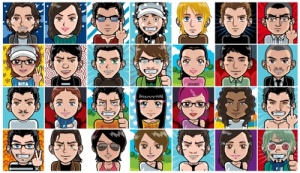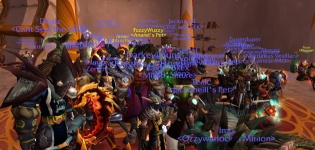Difference between revisions of "Avatar (virtual representation)"
(→Social implications) |
|||
| Line 44: | Line 44: | ||
For social, text based forums, chat rooms, and even [[Wikipedia:Social network|social networks]], they can be used to reveal or conceal a users physical identity. | For social, text based forums, chat rooms, and even [[Wikipedia:Social network|social networks]], they can be used to reveal or conceal a users physical identity. | ||
| − | == | + | == Ethical Concerns == |
| − | There are various | + | There are various ethical concerns associated with the creation and use of avatars in virtual environments. As mentioned above, avatars can be created for two-fold purposes: to reveal an identity or to conceal an identity. The question then needs to be asked, "What are some implications of creating a false identity?" and "Is it morally right to use an avatar to conceal one’s identity?" |
| − | The implications vary with the type of platform used. In the context of a textual environment like [[Wikipedia:Blogging|blogging]], where the only form of identity is a [[Wikipedia:screen name|screen name]], users may express some views that do not represent their actual feelings. This can be done to attract readers or to increase one’s fan base. Even though | + | The implications vary with the type of platform used. In the context of a textual environment like [[Wikipedia:Blogging|blogging]], where the only form of identity is a [[Wikipedia:screen name|screen name]], users may express some views that do not represent their actual feelings. This can be done to attract readers or to increase one’s fan base. Even though the impact may not appear very harmful, it can have disastrous real world consequences. For instance, there have been many reported cases of men writing as lesbian woman, which is problematic and insulting to the gay community <ref>http://www.guardian.co.uk/media/2011/jun/14/second-lesbian-blogger-exposed-paula-brooks</ref>. If readers make conclusions about a writer’s personality through his/her style of writing, the consequences are not nearly as disastrous. It is when a writer expresses false ideas that stem from their identity, that the trust fostered between the writer and their readers is broken and discarded. |
In the case of a dynamic avatar, the implications will not only concern the behavior aspect but may also extend to the physical make-up of the character. An inaccurate representation may lead to incorrect interactions with other avatars present in the virtual world. For instance, [[Wikipedia:Second life|Second life]] allows users to enter into virtual relationships and there are examples of people who have married online. A misrepresentation of gender, in this case, may drastically change the dimensions of inter sex interaction. A male avatar can be forced to believe that he is interacting with a female avatar, but in reality the female could be a false identity. A user who invests a lot time and effort in such a relationship may be misled and it may hurt his/her real emotions. | In the case of a dynamic avatar, the implications will not only concern the behavior aspect but may also extend to the physical make-up of the character. An inaccurate representation may lead to incorrect interactions with other avatars present in the virtual world. For instance, [[Wikipedia:Second life|Second life]] allows users to enter into virtual relationships and there are examples of people who have married online. A misrepresentation of gender, in this case, may drastically change the dimensions of inter sex interaction. A male avatar can be forced to believe that he is interacting with a female avatar, but in reality the female could be a false identity. A user who invests a lot time and effort in such a relationship may be misled and it may hurt his/her real emotions. | ||
Revision as of 04:58, 13 December 2011

An avatar is a representation of an individual within a virtual environment. The purpose of an avatar is to serve as a way for individuals to identify themselves and others within a virtual environment. Individuals become associated with their avatars and the actions and representations of the avatars reflect upon the identities and intentions of the users controlling them. Avatars exist within all types of virtual environments, including but not limited to:
Contents
Term Origin and History
Traditionally, an Avatar is an intentional, physical manifestation of a higher being into earthly flesh, as in Hinduism.
The use of the term in reference to a user's manifestation within a virtual environment can be traced back to 1985, when the game Ultima IV made it the goal of the player to become the Avatar, and after which the subsequent games in the series referred to your in-game, on-screen persona as the Avatar, in reference to the fourth game's storyline.
Types of Avatars

There are many different ways to present an Avatar in a virtual community. Some are designed to enhance the representation of a user's personality, and some are more geared towards representing the user's movements and interactions in virtual space.
- Textual - In some virtual environments, the only form of representation is either a textual description of the individual or an online alias like a screen name that entirely encapsulates the user's identity.
- Flat Image - Many online forums (like for example Metafilter and ChiefDelphi FIRST Robotics Forums) and other text-based communities allow users to upload images, either static or animated (GIF) depictions of whatever the user would like others to associate themselves with. These can also be portraits as in more social text-based communities. They encourage users to upload photos of themselves (not necessarily in the traditional portrait style).
- Static character - In many single player games, players manipulate a main player without the option to customize its appearance or its role in the storyline.
- Dynamic character - These are best described as virtual dolls, the appearance of which users can customize to represent themselves or to emulate any emotion or characterization of their choosing. These Avatars can be either simply dynamic visual representations, or mobile, manipulatable "bodies" within a virtual world.
Interaction
Avatars allow game users to visualize their interactions with the virtual world and in turn make it easier for them to act in a virtual environment. For example, it is easier and perhaps more natural for a player to manipulate his or her Avatar through a doorway to see a new area than it is for said player to select an option or type a request to see that new area.
Avatars help users to immerse themselves within virtual worlds and see themselves walking up to other characters, moving within landscapes, and affecting other elements within the game.
In text based virtual worlds and forums/chat rooms, the 2D images likely can be commented upon. They also help to put a out certain character traits of the user (happy, smart, serious, joking, etc.).
Identity
See also: Online Identity
Avatars are meant to represent the player within the game. They are more than just placeholders for the spatial relations in the game; users are meant to perceive their Avatar's movements (and sometimes their appearance) as the reaction to their own impulses and personality. Although people tend, if they are given the power, to design or choose avatars that closely resemble themselves or what they feel best represents their true self [1], a user may create an avatar that has no resemblance to that user (males creating female avatars and vice versa) for a number of reasons including an escape from reality (an obese person uses a skinny avatar), the ability to blend in with a specific crowd (espionage, group social requirements, etc), or others.
It is often the case that a user's avatar seems to become and be seen as an extension of the user's being. Raph Koster, in devising a declaration of the rights of players in virtual worlds, Koster wrote his "Declaration of the Rights of Avatars" [2]. Additionally, situations in which users are deeply affected by wrongful actions (such as virtual rape and griefing in general) against their avatars serve to demonstrate the synonymic view of users and their avatars we tend to take.
For social, text based forums, chat rooms, and even social networks, they can be used to reveal or conceal a users physical identity.
Ethical Concerns
There are various ethical concerns associated with the creation and use of avatars in virtual environments. As mentioned above, avatars can be created for two-fold purposes: to reveal an identity or to conceal an identity. The question then needs to be asked, "What are some implications of creating a false identity?" and "Is it morally right to use an avatar to conceal one’s identity?"
The implications vary with the type of platform used. In the context of a textual environment like blogging, where the only form of identity is a screen name, users may express some views that do not represent their actual feelings. This can be done to attract readers or to increase one’s fan base. Even though the impact may not appear very harmful, it can have disastrous real world consequences. For instance, there have been many reported cases of men writing as lesbian woman, which is problematic and insulting to the gay community [3]. If readers make conclusions about a writer’s personality through his/her style of writing, the consequences are not nearly as disastrous. It is when a writer expresses false ideas that stem from their identity, that the trust fostered between the writer and their readers is broken and discarded.
In the case of a dynamic avatar, the implications will not only concern the behavior aspect but may also extend to the physical make-up of the character. An inaccurate representation may lead to incorrect interactions with other avatars present in the virtual world. For instance, Second life allows users to enter into virtual relationships and there are examples of people who have married online. A misrepresentation of gender, in this case, may drastically change the dimensions of inter sex interaction. A male avatar can be forced to believe that he is interacting with a female avatar, but in reality the female could be a false identity. A user who invests a lot time and effort in such a relationship may be misled and it may hurt his/her real emotions.
Thus, the implications may extend to the real lives of people who interact with and control avatars. With the advent of technology and the popularity of avatars, users must think about all kinds of implications before creating an avatar.